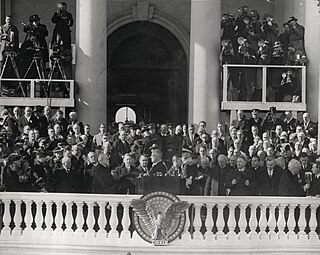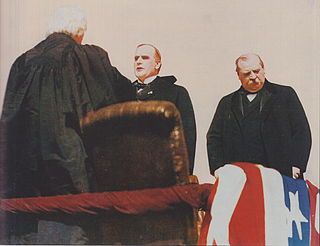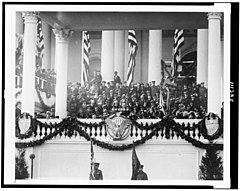
Between 73 and 79 days after the presidential election, the president-elect of the United States is inaugurated as president by taking the presidential oath of office. The inauguration takes place for each new presidential term, even if the president is continuing in office for a second term.

The first inauguration of Calvin Coolidge as the 30th president of the United States was held on Friday, August 3, 1923, at the Coolidge Homestead in Plymouth Notch, Vermont, following the death of President Warren G. Harding the previous evening. The inauguration – the sixth non-scheduled, extraordinary inauguration to ever take place – marked the commencement of the first term of Calvin Coolidge as president. The presidential oath of office was administered to the new president by his father, John Calvin Coolidge Sr., who was a Vermont notary public and justice of the peace. On Tuesday, August 21, 1923, President Coolidge repeated the oath before Justice Adolph A. Hoehling Jr. of the Court of the District of Columbia at the Willard Hotel, Washington, D.C.

The first inauguration of George W. Bush as the 43rd president of the United States took place on Saturday, January 20, 2001, at the West Front of the United States Capitol in Washington, D.C. This was the 54th inauguration and marked the commencement of the first term of George W. Bush as president and Dick Cheney as vice president. Chief Justice William Rehnquist administered the presidential oath of office at 12:01 p.m., after he administered the vice presidential oath of office as well. An estimated 300,000 people attended the swearing-in ceremony. This was the first presidential inauguration to take place in the 21st century, and the first in the 3rd millennium.

The second inauguration of Bill Clinton as president of the United States was held on Monday, January 20, 1997, at the West Front of the United States Capitol Building in Washington, D.C. This was the 53rd inauguration and marked the commencement of the second and final term of Bill Clinton as president and Al Gore as vice president. This was the last presidential inauguration to take place in the 20th century, the last in the 2nd millennium, and the first to be streamed live on the internet.

The inauguration of George H. W. Bush as the 41st president of the United States was held on Friday, January 20, 1989, at the West Front of the United States Capitol in Washington, D.C. This was the 51st inauguration and marked the commencement of the only term of both George H. W. Bush as president and Dan Quayle as vice president. Chief Justice William Rehnquist administered the presidential oath of office to Bush and Justice Sandra Day O'Connor administered the vice presidential oath of office to Quayle. Bush was the first sitting vice president to be inaugurated as president since Martin Van Buren in 1837 and the last World War II combat veteran. Bush composed his own prayer for the ceremony which he recited at the start of his inaugural address; the last president to do so was Dwight D. Eisenhower at his first inauguration in 1953.

The inauguration of Jimmy Carter as the 39th president of the United States was held on Thursday, January 20, 1977, at the East Portico of the United States Capitol in Washington D.C. This was the 48th inauguration and marked the commencement of Jimmy Carter's and Walter Mondale's single term as president and vice president. Chief Justice Warren E. Burger administered the presidential oath of office to Carter, and Speaker of the House Tip O'Neill administered the vice presidential oath of office to Mondale. This was the last inauguration held on the East Portico of the Capitol building as well as the last time the chief justice would stand to the left of the podium, with the audience facing them, while swearing in a president. Exactly forty years later, Carter attended the inauguration of Donald Trump, becoming the first U.S. president to mark the 40th anniversary of his inauguration.

The second inauguration of Richard Nixon as president of the United States was held on Saturday, January 20, 1973, at the East Portico of the United States Capitol in Washington, D.C. This was the 47th inauguration and marked the commencement of the second and final term of both Richard Nixon as president and Spiro Agnew as vice president. Both Agnew and Nixon resigned within two years of this term. In December 1973, Gerald Ford replaced Agnew as vice president and in the following year, replaced Nixon as president. This made Nixon the first and, as of 2023, only person to be inaugurated four times as both president and vice president. Chief Justice Warren E. Burger administered both the presidential and vice presidential oaths of office. During the ceremony, Look With Pride On Our Flag, a song dedicated to President Nixon and composed by Hank Fort, was played.

The first inauguration of Richard Nixon as the 37th president of the United States was held on Monday, January 20, 1969, at the East Portico of the United States Capitol in Washington, D.C. This was the 46th inauguration and marked the commencement of the first and eventually only full term of both Richard Nixon as president and Spiro Agnew as vice president. Chief Justice Earl Warren administered the presidential oath of office to Nixon, and Senate Minority Leader Everett Dirksen administered the vice presidential oath to Agnew. Nixon was the first non-incumbent vice president to be inaugurated as president. This was also the last presidential oath administered by Chief Justice Warren.

The second inauguration of Dwight D. Eisenhower as president of the United States was held privately on Sunday, January 20, 1957, at the White House and publicly on the following day, Monday, January 21, 1957, at the East Portico of the United States Capitol; both located in Washington, D.C. This was the 43rd inauguration and marked the commencement of the second and final four-year term of both Dwight D. Eisenhower as president and Richard Nixon as vice president. Chief Justice Earl Warren administered the presidential oath of office after the Senate Minority Leader William Knowland swore in the vice president.

The first inauguration of Dwight D. Eisenhower as the 34th president of the United States was held on Tuesday, January 20, 1953, at the East Portico of the United States Capitol in Washington, D.C. This was the 42nd inauguration and marked the commencement of the first term of Dwight D. Eisenhower as president and of Richard Nixon as vice president. Chief Justice Fred M. Vinson administered the presidential oath of office to Eisenhower. The vice presidential oath was administered to Nixon by Senator William Knowland.

The third inauguration of Franklin D. Roosevelt as president of the United States was held on Monday, January 20, 1941, at the East Portico of the United States Capitol in Washington, D.C. This was the 39th inauguration and marked the commencement of the third, and eventually final full term of Franklin D. Roosevelt as president and the only term of Henry A. Wallace as vice president. This was the first and only time a president has been inaugurated for a third term; after the Twenty-second Amendment to the United States Constitution was ratified in 1951, no person can be elected president more than twice.

The inauguration of William Howard Taft as the 27th president of the United States was held on Thursday, March 4, 1909, at the Senate chamber inside the United States Capitol, Washington, D.C., instead of the regular East Portico due to blizzard. This was the 31st inauguration and marked the commencement of William Howard Taft's only term as president and James S. Sherman's only term as vice president.

The first inauguration of William McKinley as the 25th president of the United States took place on Thursday, March 4, 1897, in front of the Old Senate Chamber at the United States Capitol, Washington, D.C. This was the 28th inauguration and marked the commencement of the first, and eventually only full term of William McKinley as president and the only term of Garret Hobart as vice president. Chief Justice Melville Fuller administered the presidential oath of office. This was the first inauguration to be recorded on film, and was the last presidential inauguration to take place in the 19th century. Hobart died 2 years, 262 days into this term, and the office remained vacant since there was no constitutional provision which allow an intra-term vice-presidential office filling; it would be regulated by the Twenty-fifth Amendment in 1967.

The second inauguration of William McKinley as president of the United States was held on Monday, March 4, 1901, at the East Portico of the United States Capitol in Washington, D.C. This was the 29th inauguration and marked the commencement of the second and final term of William McKinley as president and the only term of Theodore Roosevelt as vice president. McKinley died 194 days into this term, and Roosevelt succeeded in the presidency.

The inauguration of Franklin Pierce as the 14th president of the United States was held on Friday, March 4, 1853, at the East Portico of the United States Capitol in Washington, D.C. This was the 17th inauguration and marked the commencement of the only four-year term of both Franklin Pierce as president and William R. King as vice president. Chief Justice Roger B. Taney administered the presidential oath of office. Pierce affirmed the oath of office rather than swear it, and was also the first president to recite his inaugural address from memory.

The first inauguration of Grover Cleveland as the 22nd president of the United States took place on Wednesday, March 4, 1885, at the East Portico of the United States Capitol in Washington, D.C. This was the 25th inauguration and marked the commencement of the first four-year term of Grover Cleveland as president and the only term of Thomas A. Hendricks as vice president. Hendricks died 266 days into this term, and the office remained vacant since there was no constitutional provision which allow an intra-term vice-presidential office filling; it would be regulated by the Twenty-fifth Amendment in 1967.

The second inauguration of Grover Cleveland as the 24th president of the United States took place on Saturday, March 4, 1893, at the East Portico of the United States Capitol in Washington, D.C. This was the 27th inauguration and marked the commencement of the second and final four-year term of Grover Cleveland as president and the only term of Adlai Stevenson I as vice president. Cleveland had previously been the 22nd president, and was the only president to serve two non-consecutive terms. Chief Justice Melville Fuller administered the presidential oath of office. It snowed during the inauguration.

The second inauguration of Woodrow Wilson as president of the United States was held privately on Sunday, March 4, 1917, at the President's Room inside the United States Capitol in Washington, D.C., and publicly on Monday, March 5, 1917, at the East Portico of the Capitol. This was the 33rd inauguration and marked the commencement of the second and final four-year term of both Woodrow Wilson as president and Thomas R. Marshall as vice president. Chief Justice Edward D. White administered the presidential oath of office to Wilson.

The inauguration of Warren G. Harding as the 29th president of the United States was held on Friday, March 4, 1921, at the East Portico of the United States Capitol in Washington, D.C. This was the 34th inauguration and marked the commencement of Warren G. Harding's only term as president and of Calvin Coolidge's only term as vice president. Harding died 2 years, 151 days into this term, and Coolidge succeeded to the presidency.

The inauguration of Herbert Hoover as the 31st president of the United States was held on Monday, March 4, 1929, at the East Portico of the United States Capitol in Washington, D.C. This was the 36th inauguration and marked the commencement of the only term of both Herbert Hoover as president and Charles Curtis as vice president. Chief Justice and former President William Howard Taft administered the presidential oath of office to Hoover. This was the first presidential inauguration to be recorded by sound newsreels. Following the second inauguration of Calvin Coolidge, overseen by Taft exactly four years earlier, it was also the second time that a former president administered the oath of office to a new president.

























